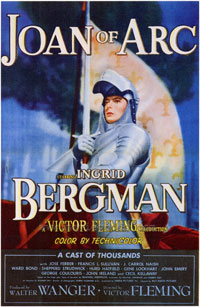Development
Joan of Arc was made in 1947–1948 by an independent company, Sierra Pictures, created especially for this production, and not to be confused with the production company with the same name that made mostly silent films.
Filming began on September 16, 1947 [5] and was done primarily at Hal Roach Studios, with location scenes shot in the Los Angeles area.
The 1948 Sierra Pictures never produced another film after Joan of Arc.
Casting
Bergman had been lobbying to play Joan for many years, and this film was considered a dream project for her. It received mixed reviews and lower-than-expected box office, though it clearly was not a "financial disaster" as is often claimed. Donald Spoto, in a biography of Ingrid Bergman, even claims that "the critics' denunciations notwithstanding, the film earned back its investment with a sturdy profit". [6]
The movie is considered by some to mark the start of a low period in the actress's career that lasted until she made Anastasia in 1956. In April 1949, five months after the release of the film, and before it had gone out on general release, the revelation of Bergman's extramarital relationship with Italian director Roberto Rossellini brought her American screen career to a temporary halt. The nearly two-and-a-half-hour film was drastically edited for its general release, and was not restored to its original length for nearly 50 years.
Bergman and co-star José Ferrer (making his first film appearance and playing the Dauphin) [7] received Academy Award nominations for their performances. The film was director Victor Fleming's last project—he died only two months after its release.
In Michael Sragow's 2008 biography of the director, he claims that Fleming, who was, according to Sragrow, romantically involved with Ingrid Bergman at the time, was deeply unhappy with the finished product, and even wept upon seeing it for the first time. [8] Sragrow speculates that the disappointment of the failed relationship and the failure of the film may have led to Fleming's fatal heart attack, but there is no real evidence to support this. While contemporary critics may have agreed with Fleming's assessment of Joan of Arc, more recent reviewers of the restored complete version on DVD have not. [9] [10] [11] [12]
